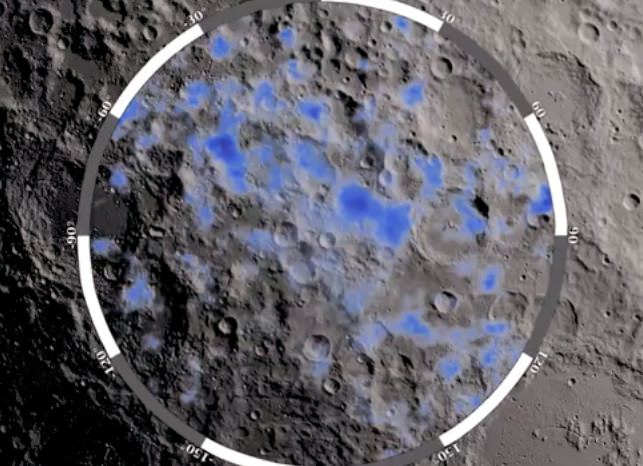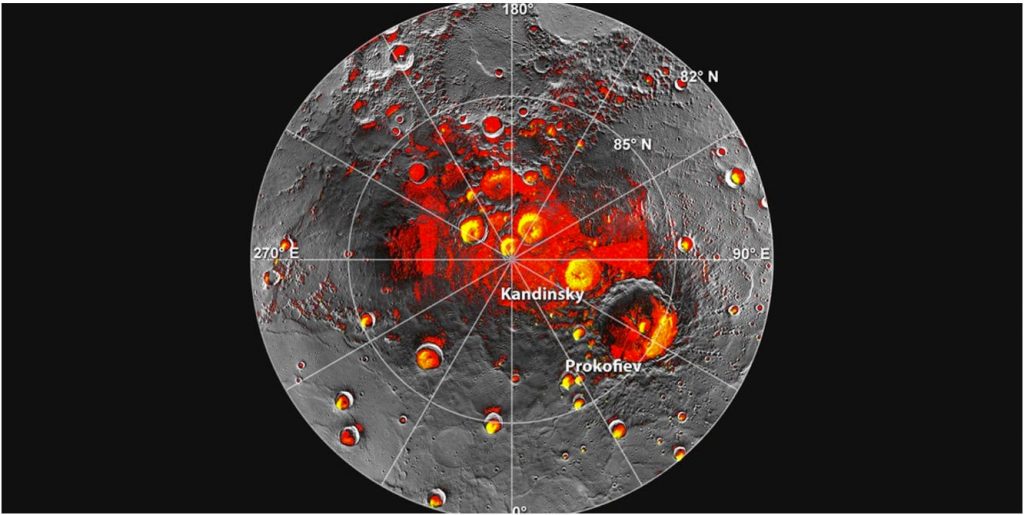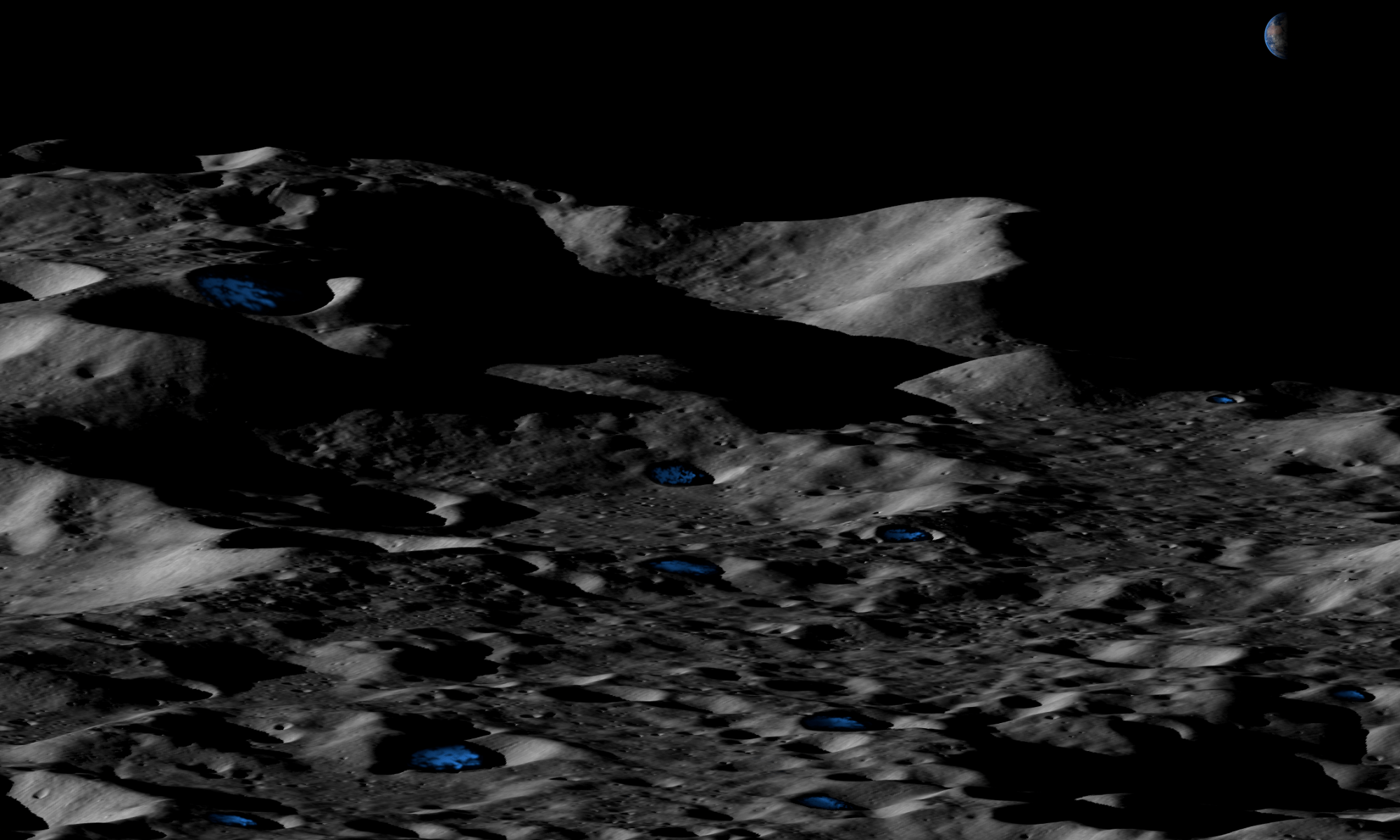In addition to being the only solvent that is capable of supporting life, water is essential to life as we know it here on Earth. Because of this, finding deposits of water – whether in liquid form or as ice – on other planets is always exciting. Even where is not seen as a potential indication of life, the presence of water offers opportunities for exploration, scientific study, and even the creation of human outposts.
This has certainly been the case as far as the Moon and Mercury are concerned, where water ice was discovered in the permanently-shadowed cratered regions around the poles. But according to a new analysis of the data from the Lunar Reconnaissance Orbiter and the MESSENGER spacecraft, the Moon and Mercury may have significantly more water ice than previously thought.
The study that describes the new findings recently appeared in the journal Nature Geoscience. The team was led by Lior Rubanenko and David A. Paige – a graduate student and professor of planetary science from the Department of Earth, Planetary and Space Sciences at the University of California, Los Angeles (UCLA) – with assistance provided by Jaahnavee Venkatrama, a Statistician and UCLA graduate.

When it comes right down to it, Mercury and the Moon have a lot in common. Both are terrestrial (aka. rocky) in nature, composed of silicate minerals and metals that are differentiated between a metallic core and silicate mantle and crust. In addition, they are both oriented in such a way that the Sun never rises high above the horizon, leaving them permanently-shaded.
As a result, these regions are some of the coldest in the Solar System, and topographic depressions (like impact craters) receive no sunlight at all. For decades, scientists have theorized that water ice trapped within them could potentially survive for billions of years. In recent years, this was confirmed by missions like the Lunar Reconnaissance Orbiter (LRO) and the MESSENGER orbiter.
These observations revealed glacier-like ice deposits on Mercury but not the Moon, despite the fact that their polar thermal environments are very similar to each other. However, previous radar and imaging studies showed only patchy, shallow ice deposits in places like the Shakleton crater and other low-lying areas in the South Pole-Aitken Basin.
Nancy Chabot is the instrument scientist for MESSENGER’s Mercury Dual Imaging System from the Johns Hopkins Applied Physics Laboratory (JHUAPL). As she explained:
“We showed Mercury’s polar deposits to be dominantly composed of water ice and extensively distributed in both Mercury’s north and south polar regions. Mercury’s ice deposits appear to be much less patchy than those on the Moon, and relatively fresh, perhaps emplaced or refreshed within the last tens of millions of years.”

This inexplicable difference between Mercury and the Moon is what motivated the UCLA team to conduct a comparative analysis of polar craters on Mercury and the Moon to delve into this difference between the two worlds. By looking over the data again, their analysis raises the possibility that thick ice deposits could also exist in the Moon’s cratered regions.
This conclusion was reached by examining elevation data obtained by MESSENGER and LRO of roughly 15,000 simple craters on Mercury and the Moon that were formed by smaller, less energetic impacts. These craters are between 2.5 km to 15 km (~1.5 mi to 9.3 mi) in diameter, are held together by the strength of the surface dust layer, and tend to be more circular and symmetrical than large craters.
The UCLA scientists used this inherent symmetry to estimate the thickness of ice trapped within them. What they found was that of the craters they examined, a significant number of them were up to 10% shallower when situated near the north pole on Mercury and the south pole of the Moon, but not near the Moon’s north pole.
The team concluded that the most probable explanation for this difference in depth is the accumulation of thick ice deposits on both worlds. This was supported by the fact that the pole-facing slopes of these craters appear to be slightly shallower than their equator-facing slopes and that these differences are more significant in regions where ice stability is promoted by Mercury’s orbit around the Sun.
They also found that these potential subsurface ice deposits coincide with craters that have surface ice. As Rubanenko summarized:
“We found shallow craters tend to be located in areas where surface ice was previously detected near the south pole of the Moon, and inferred this shallowing is most likely due to the presence of buried thick ice deposits.”
And while the ice in Mercury’s cratered northern region has been found to be nearly pure, the deposits detected on the Moon are most likely mixed with the regolith and layered. Lastly, while this trend was observed for smaller simple craters, it does not preclude the possibility that ice could be widespread in larger craters too.
This research may not only help resolve the question regarding the apparent low-abundance of lunar ice (relative to Mercury), it could also have practical applications. Said Noah Petro, the LRO
With multiple plans in place to build research outposts in the Moon’s South Pole-Aitken Basin, the possible presence of even more water ice is very good news. If confirmed, these abundant caches of water ice could facilitate more in the way of outposts, fuel manufacturing operations, the creation of refueling depots, and maybe even a permanent lunar settlement.

